Urban Microclimate, Outdoor Thermal Comfort, and Socio-Economic Mapping: A Case Study of Philadelphia, PA
Abstract
1. Introduction
2. Methodology and Case Study
2.1. Step 1: Exploring Social Vulnerability Index to Identify Neighborhoods
2.2. Step 2: Microclimate and Outdoor Thermal Comfort Simulation
3. Results and Discussion
- PMV values at 10:00 am, summer
- PMV values at 02:00 pm, summer
- PMV values at 06:00 pm, summer
- PMV values at 10:00 pm, summer
- North to South primary street, on asphalt (N-S)PA
- East to West primary street, on asphalt (E-W)PA
- North to South secondary street, on asphalt (N-S)SA
- East to West secondary street, on asphalt (E-W)SA
- North to South primary street, on pavement (N-S)PP
- East to West primary street, on pavement (E-W)PP
- North to South secondary street, on pavement (N-S)SP
- East to West secondary street, on pavement (E-W)SP
- Under Tress (TRS)
4. Conclusions
Author Contributions
Funding
Data Availability Statement
Acknowledgments
Conflicts of Interest
References
- Masson-Delmotte, T.W.; Zhai, P.; Pörtner, H.-O.; Roberts, D.; Skea, J.; Shukla, P.R.; Pirani, A.; Moufouma-Okia, W.; Péan, C.; Pidcock, R.; et al. Global Warming of 1.5 °C. An IPCC Special Report on the Impacts of Global Warming of 1.5 °C above Pre-industrial Levels and Related Global Greenhouse Gas Emission Pathways, in the Context of Strengthening the Global Response to the Threat of Climate Change. 2018. Available online: https://www.ipcc.ch/sr15/ (accessed on 17 February 2022).
- P. D. United Nations, Department of Economic & Social Affairs. World Urbanization Prospects: The 2018 Revision; United Nations: New York, NY, USA, 2019; Available online: https://population.un.org/wup/publications/Files/WUP2018-Report.pdf (accessed on 13 March 2022).
- Taha, H. Urban climates and heat islands: Albedo, evapotranspiration, and anthropogenic heat. Energy Build. 1997, 25, 99–103. [Google Scholar] [CrossRef]
- Unger, J. Connection between urban heat island and sky view factor approximated by a software tool on a 3D urban database. Int. J. Environ. Pollut. 2009, 36, 59. [Google Scholar] [CrossRef]
- Landsberg, H.E. Urban energy fluxes. In The Urban Climate; University of Maryland: College Park, MD, USA, 1981; pp. 53–82. [Google Scholar]
- Oke, T.R. The energetic basis of the urban heat island. Q. J. R. Meteorol. Soc. 1982, 108, 1–24. [Google Scholar] [CrossRef]
- Taha, H. Characterization of Urban Heat and Exacerbation: Development of a Heat Island Index for California. Climate 2017, 5, 59. [Google Scholar] [CrossRef]
- Santamouris, M. Science of the Total Environment Analyzing the heat island magnitude and characteristics in one hundred Asian and Australian cities and regions. Sci. Total Environ. 2015, 512–513, 582–598. [Google Scholar] [CrossRef]
- Peng, S.; Piao, S.; Ciais, P.; Friedlingstein, P.; Ottle, C.; Bréon, F.-M.; Nan, H.; Zhou, L.; Myneni, R.B. Surface Urban Heat Island Across 419 Global Big Cities. Environ. Sci. Technol. 2011, 46, 696–703. [Google Scholar] [CrossRef] [PubMed]
- Estoque, R.C.; Murayama, Y.; Myint, S.W. Science of the Total Environment Effects of landscape composition and pattern on land surface temperature: An urban heat island study in the megacities of Southeast Asia. Sci. Total. Environ. 2017, 577, 349–359. [Google Scholar] [CrossRef] [PubMed]
- Ho, H.C.; Knudby, A.; Chi, G.; Aminipouri, M.; Lai, D.Y.-F. Spatiotemporal analysis of regional socio-economic vulnerability change associated with heat risks in Canada. Appl. Geogr. 2018, 95, 61–70. [Google Scholar] [CrossRef] [PubMed]
- Khatana, S.A.M.; Werner, R.M.; Groeneveld, P.W. Association of Extreme Heat with All-Cause Mortality in the Contiguous US, 2008–2017. JAMA Netw. Open 2022, 5, e2212957. [Google Scholar] [CrossRef]
- Centers for Disease Control and Prevention. National Environmental Public Health Tracking Network. 2023. Available online: www.cdc.gov/ephtracking (accessed on 10 May 2022).
- Anderson, G.B.; Bell, M.L. Heat Waves in the United States: Mortality Risk during Heat Waves and Effect Modification by Heat Wave Characteristics in 43 U.S. Communities. Environ. Health Perspect. 2011, 119, 210–218. [Google Scholar] [CrossRef]
- Heaton, M.J.; Sain, S.R.; Greasby, T.A.; Uejio, C.K.; Hayden, M.H.; Monaghan, A.J.; Boehnert, J.; Sampson, K.; Banerjee, D.; Nepal, V.; et al. Characterizing urban vulnerability to heat stress using a spatially varying coefficient model. Spat. Spatio-Temporal Epidemiol. 2014, 8, 23–33. [Google Scholar] [CrossRef] [PubMed]
- Madrigano, J.; Ito, K.; Johnson, S.; Kinney, P.L.; Matte, T. A Case-Only Study of Vulnerability to Heat Wave—Related Mortality. Environ. Health Perspect. 2015, 123, 672–678. [Google Scholar] [CrossRef] [PubMed]
- Hsu, A.; Manya, D. Intensity across Major US Cities. Nat. Commun. 2021, 12, 2721. [Google Scholar] [CrossRef] [PubMed]
- Yang, W.; Wong, N.H.; Jusuf, S.K. Thermal comfort in outdoor urban spaces in Singapore. Build. Environ. 2013, 59, 426–435. [Google Scholar] [CrossRef]
- Aljawabra, F.; Nikolopoulou, M. Thermal comfort in urban spaces: A cross-cultural study in the hot arid climate. Int. J. Biometeorol. 2018, 62, 1901–1909. [Google Scholar] [CrossRef]
- Salata, F.; Golasi, I.; Vollaro, R.D.L.; Vollaro, A.D.L. Outdoor thermal comfort in the Mediterranean area. A transversal study in Rome, Italy. Build. Environ. 2016, 96, 46–61. [Google Scholar] [CrossRef]
- Huang, J.; Zhou, C.; Zhuo, Y.; Xu, L.; Jiang, Y. Outdoor thermal environments and activities in open space: An experiment study in humid subtropical climates. Build. Environ. 2016, 103, 238–249. [Google Scholar] [CrossRef]
- Xu, M.; Hong, B.; Mi, J.; Yan, S. Outdoor thermal comfort in an urban park during winter in cold regions of China. Sustain. Cities Soc. 2018, 43, 208–220. [Google Scholar] [CrossRef]
- Hirashima, S.Q.D.S.; de Assis, E.S.; Nikolopoulou, M. Daytime thermal comfort in urban spaces: A field study in Brazil. Build. Environ. 2016, 107, 245–253. [Google Scholar] [CrossRef]
- Middel, A.; Selover, N.; Hagen, B.; Chhetri, N. Impact of shade on outdoor thermal comfort—A seasonal field study in Tempe, Arizona. Int. J. Biometeorol. 2016, 60, 1849–1861. [Google Scholar] [CrossRef]
- Chi, G.Q.; Ho, H.C. Population stress: A spatiotemporal analysis of population change and land development at the county level in the contiguous United States, 2001–2011. Land Use Policy 2018, 70, 128–137. [Google Scholar] [CrossRef]
- Chi, J.; Zhu, G. Spatial Regression Models for the Social Sciences; SAGE Publications: Thousand Oaks, CA, USA, 2019. [Google Scholar]
- Toparlar, Y.; Blocken, B.; Maiheu, B.; van Heijst, G. A review on the CFD analysis of urban microclimate. Renew. Sustain. Energy Rev. 2017, 80, 1613–1640. [Google Scholar] [CrossRef]
- Crank, P.J.; Sailor, D.J.; Ban-Weiss, G.; Taleghani, M. Evaluating the ENVI-met microscale model for suitability in analysis of targeted urban heat mitigation strategies. Urban Clim. 2018, 26, 188–197. [Google Scholar] [CrossRef]
- Ozkeresteci, I.; Crewe, K.; Brazel, A.J.; Bruse, M. Use and evaluation of the ENVI-met model for environmental design and planning. An Experiment on Lienar Parks. In Proceedings of the 21st International Cartographic Conference (ICC), Durban, South Africa, 10–16 August 2003; pp. 10–16. [Google Scholar]
- Rodríguez Algeciras, J.A.; Gómez Consuegra, L.; Matzarakis, A. Spatial-temporal study on the effects of urban street configurations on human thermal comfort in the world heritage city of Camagüey-Cuba. Build. Environ. 2016, 101, 85–101. [Google Scholar] [CrossRef]
- Sinsel, T. Advancements and Applications of the Microclimate Model ENVI-Met; Johannes Gutenberg-Universitat Mainz: Mainz, Germany, 2022. [Google Scholar] [CrossRef]
- Ayyad, Y.N.; Sharples, S. Envi-MET validation and sensitivity analysis using field measurements in a hot arid climate. IOP Conf. Series Earth Environ. Sci. 2019, 329, 012040. [Google Scholar] [CrossRef]
- Acero, J.A.; Arrizabalaga, J. Evaluating the performance of ENVI-met model in diurnal cycles for different meteorological conditions. Theor. Appl. Clim. 2018, 131, 455–469. [Google Scholar] [CrossRef]
- Acero, J.A.; Herranz-Pascual, K. A comparison of thermal comfort conditions in four urban spaces by means of measurements and modelling techniques. Build. Environ. 2015, 93, 245–257. [Google Scholar] [CrossRef]
- Alsaad, H.; Hartmann, M.; Hilbel, R.; Voelker, C. ENVI-met validation data accompanied with simulation data of the impact of facade greening on the urban microclimate. Data Brief 2022, 42, 108200. [Google Scholar] [CrossRef]
- Morakinyo, T.E.; Lai, A.; Lau, K.K.-L.; Ng, E. Thermal benefits of vertical greening in a high-density city: Case study of Hong Kong. Urban For. Urban Green. 2019, 37, 42–55. [Google Scholar] [CrossRef]
- Forouzandeh, A. Numerical modeling validation for the microclimate thermal condition of semi-closed courtyard spaces between buildings. Sustain. Cities Soc. 2018, 36, 327–345. [Google Scholar] [CrossRef]
- Elraouf, R.A.; Elmokadem, A.; Megahed, N.; Eleinen, O.A.; Eltarabily, S. Evaluating urban outdoor thermal comfort: A validation of ENVI-met simulation through field measurement. J. Build. Perform. Simul. 2022, 15, 268–286. [Google Scholar] [CrossRef]
- US Census Bureau. 2022. Available online: https://www.census.gov/quickfacts/fact/table/US/PST045222 (accessed on 23 January 2023).
- Mayor’s Office of Sustainability and ICF International. Growing Stronger: Toward a Climate-Ready Philadelphia. 2015. Available online: https://www.phila.gov/documents/growing-stronger-toward-a-climate-ready-philadelphia/ (accessed on 1 March 2023).
- Schade, R.S. Philadelphia Rowhouse Manual: A Practical Guide for Homeowners; The City of Philadelphia: Philadelphia, PA, USA, 2008. Available online: https://www.phila.gov/media/20190521124726/Philadelphia_Rowhouse_Manual.pdf (accessed on 18 July 2021).
- Baechler, P.M.; Michael, C.; Williamson, J.L.; Gilbride, T.L.; Cole, P.C.H.; Marye, G.L. Building America Best Practices Series: Volume 7.1: Guide to Determining Climate Regions by County. 2010. Available online: https://www.osti.gov/biblio/1068658 (accessed on 22 July 2021).
- Centers for Disease Control and Prevention/Agency for Toxic Substances and Disease Registry/Geospatial Research, Analysis, and Services Program. 2018. Available online: https://www.atsdr.cdc.gov/placeandhealth/svi/data_documentation_download.html (accessed on 15 June 2021).
- U.S. Census Bureau. 2009. Available online: https://www.census.gov/library/publications/2008/compendia/statab/128ed.html (accessed on 21 August 2021).
- Bruse, M.; Fleer, H. Simulating surface–plant–air interactions inside urban environments with a three dimensional numerical model. Environ. Model. Softw. 1998, 13, 373–384. [Google Scholar] [CrossRef]
- Shaw, E.W. Thermal Comfort: Analysis and applications in environmental engineering, by P. O. Fanger. 244 pp. DANISH TECHNICAL PRESS. Copenhagen, Denmark, 1970. Danish Kr. 76, 50. R. Soc. Health J. 1972, 92, 164. [Google Scholar] [CrossRef]
- Havenith, G.; Holmér, I.; Parsons, K. Personal factors in thermal comfort assessment: Clothing properties and metabolic heat production. Energy Build. 2002, 34, 581–591. [Google Scholar] [CrossRef]
- Pennsylvania Spatial Data Access PASDA. The Pennsylvania State University. 2016. Available online: http://www.pasda.psu.edu/ (accessed on 15 August 2021).
- Hashemi, F.; Marmur, B.; Passe, U.; Thompson, J. Developing a workflow to integrate tree inventory data into urban energy models. In SimAUD 2018 Symposium on Simulation for Architecture and Urban Design; Simulation Series; TU Delft: Delft, The Netherlands, 2018; Volume 50. [Google Scholar]
- Hashemi, F.; Iulo, L.D.; Poerschke, U. A novel approach for investigating canopy heat island effects on building energy performance: A case study of Center City of Philadelphia, PA. In Proceedings of the AIA/ACSA Intersections Research Conference: CARBON, Fall Conference Proceedings, Washington, DC, USA, 30 September – 2 October 2020; pp. 197–203. [Google Scholar] [CrossRef]
- Roudsari, M.S.; Pak, M.; Smith, A.; Gill, G. Ladybug: A Parametric Environmental Plugin For Grasshopper To Help Designers Create An Environmentally-conscious Design. In Proceedings of the Building Simulation, Chambéry, France, 26–28 August 2013; pp. 3128–3135. [Google Scholar] [CrossRef]
- Stewart, I.D.; Oke, T.R. Local Climate Zones for Urban Temperature Studies. Bull. Am. Meteorol. Soc. 2012, 93, 1879–1900. [Google Scholar] [CrossRef]
- Ali-Toudert, F.; Mayer, H. Numerical study on the effects of aspect ratio and orientation of an urban street canyon on outdoor thermal comfort in hot and dry climate. Build. Environ. 2006, 41, 94–108. [Google Scholar] [CrossRef]
- de Abreu-Harbich, L.V.; Labaki, L.C.; Matzarakis, A. Effect of tree planting design and tree species on human thermal comfort in the tropics. Landsc. Urban Plan. 2015, 138, 99–109. [Google Scholar] [CrossRef]
- Gatto, E.; Buccolieri, R.; Aarrevaara, E.; Ippolito, F.; Emmanuel, R.; Perronace, L.; Santiago, J.L. Impact of Urban Vegetation on Outdoor Thermal Comfort: Comparison between a Mediterranean City (Lecce, Italy) and a Northern European City (Lahti, Finland). Forests 2020, 11, 228. [Google Scholar] [CrossRef]
- Zaki, S.A.; Toh, H.J.; Yakub, F.; Saudi, A.S.M.; Ardila-Rey, J.A.; Muhammad-Sukki, F. Effects of Roadside Trees and Road Orientation on Thermal Environment in a Tropical City. Sustainability 2020, 12, 1053. [Google Scholar] [CrossRef]
- Bernabé, A.; Bernard, J.; Musy, M.; Andrieu, H.; Bocher, E.; Calmet, I.; Kéravec, P.; Rosant, J.-M. Radiative and heat storage properties of the urban fabric derived from analysis of surface forms. Urban Clim. 2015, 12, 205–218. [Google Scholar] [CrossRef]
- Elraouf, R.A.; Elmokadem, A.; Megahed, N.; Eleinen, O.A.; Eltarabily, S. The impact of urban geometry on outdoor thermal comfort in a hot-humid climate. Build. Environ. 2022, 225, 109632. [Google Scholar] [CrossRef]
- Zhang, Y.; Du, X.; Shi, Y. Effects of street canyon design on pedestrian thermal comfort in the hot-humid area of China. Int. J. Biometeorol. 2017, 61, 1421–1432. [Google Scholar] [CrossRef] [PubMed]
- Zaki, S.; Azid, N.; Shahidan, M.; Hassan, M.; Daud, M.; Abu Bakar, N.; Salim, S.A.Z.S.; Yakub, F. Analysis of Urban Morphological Effect on the Microclimate of the Urban Residential Area of Kampung Baru in Kuala Lumpur Using a Geospatial Approach. Sustainability 2020, 12, 7301. [Google Scholar] [CrossRef]

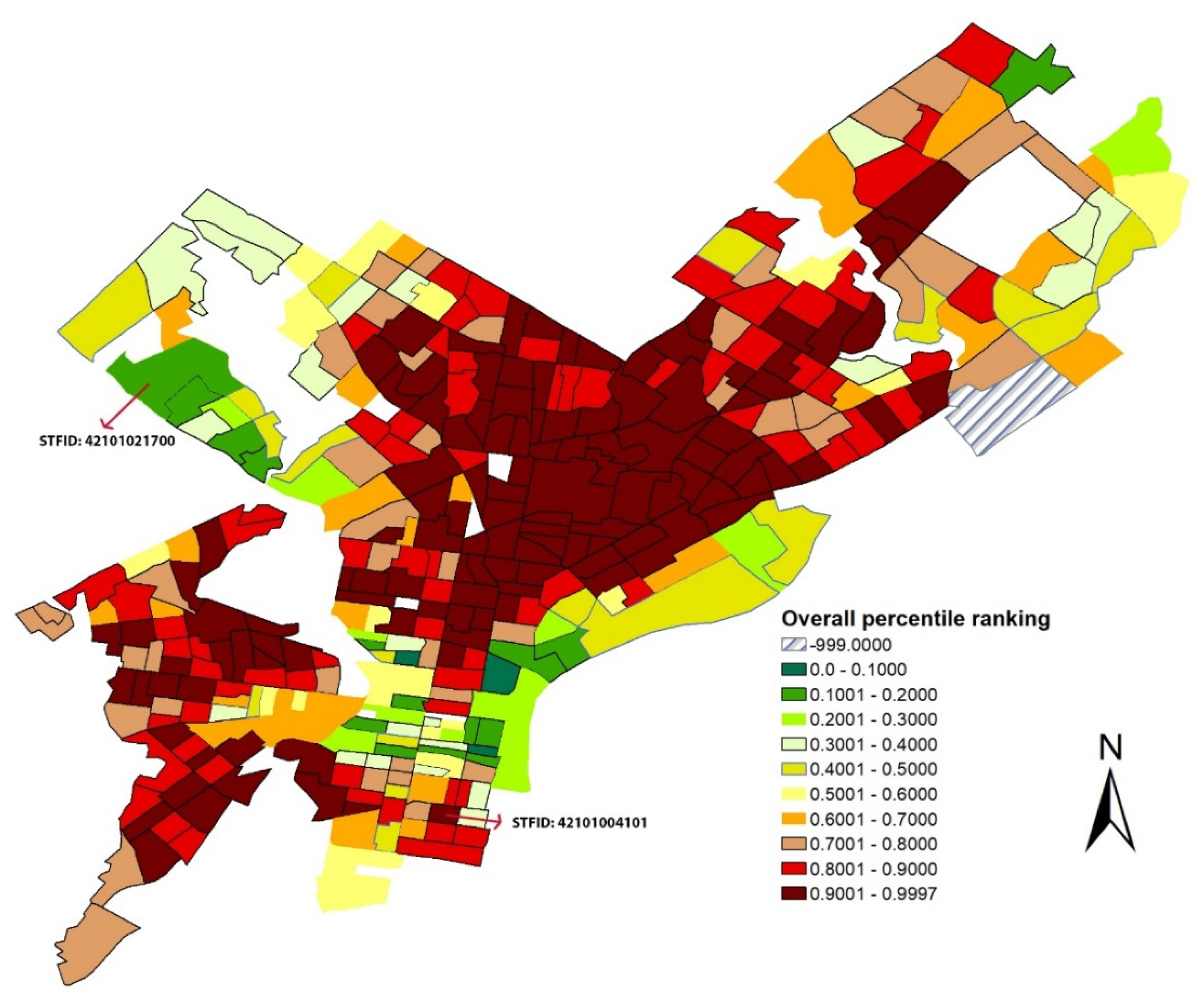
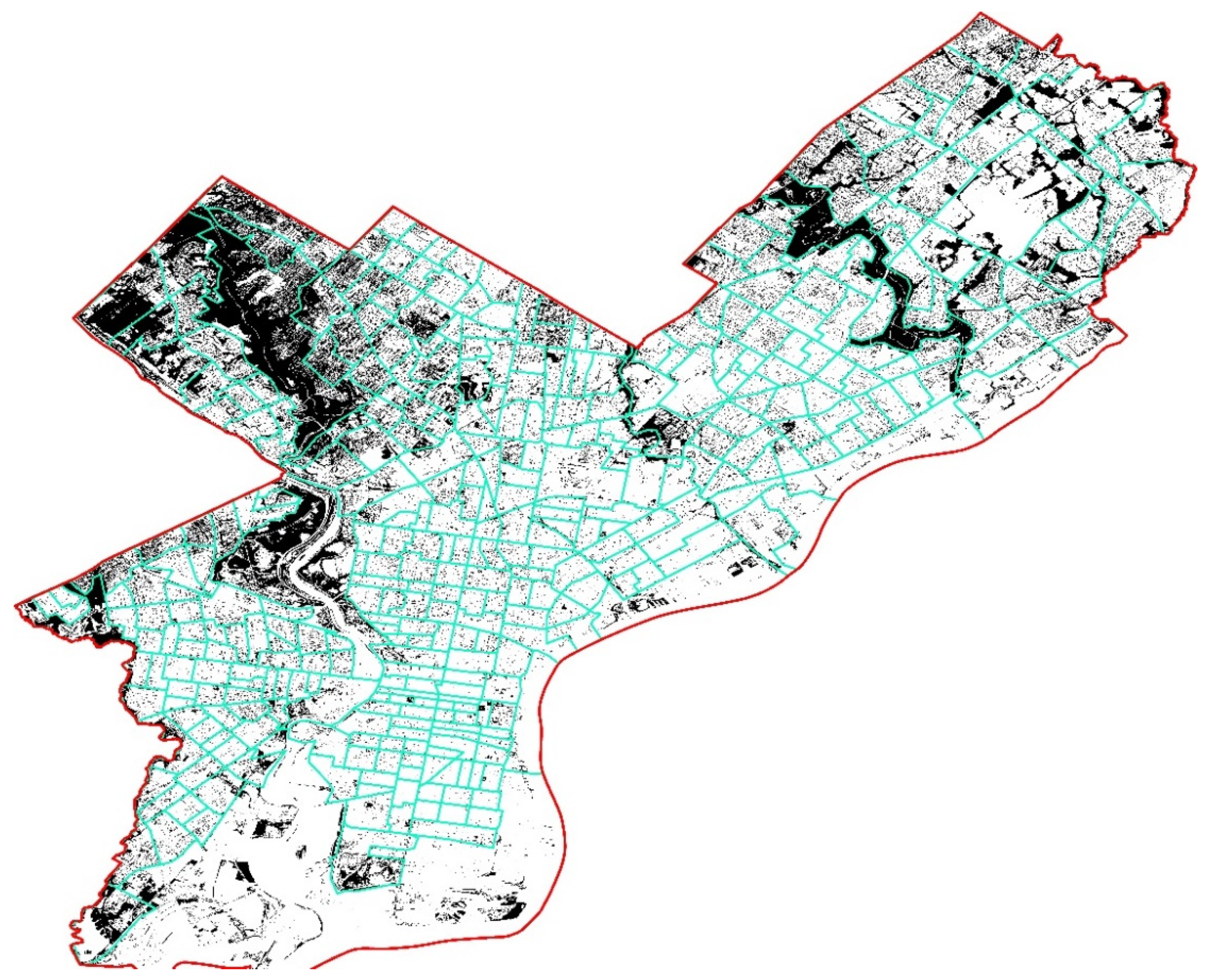
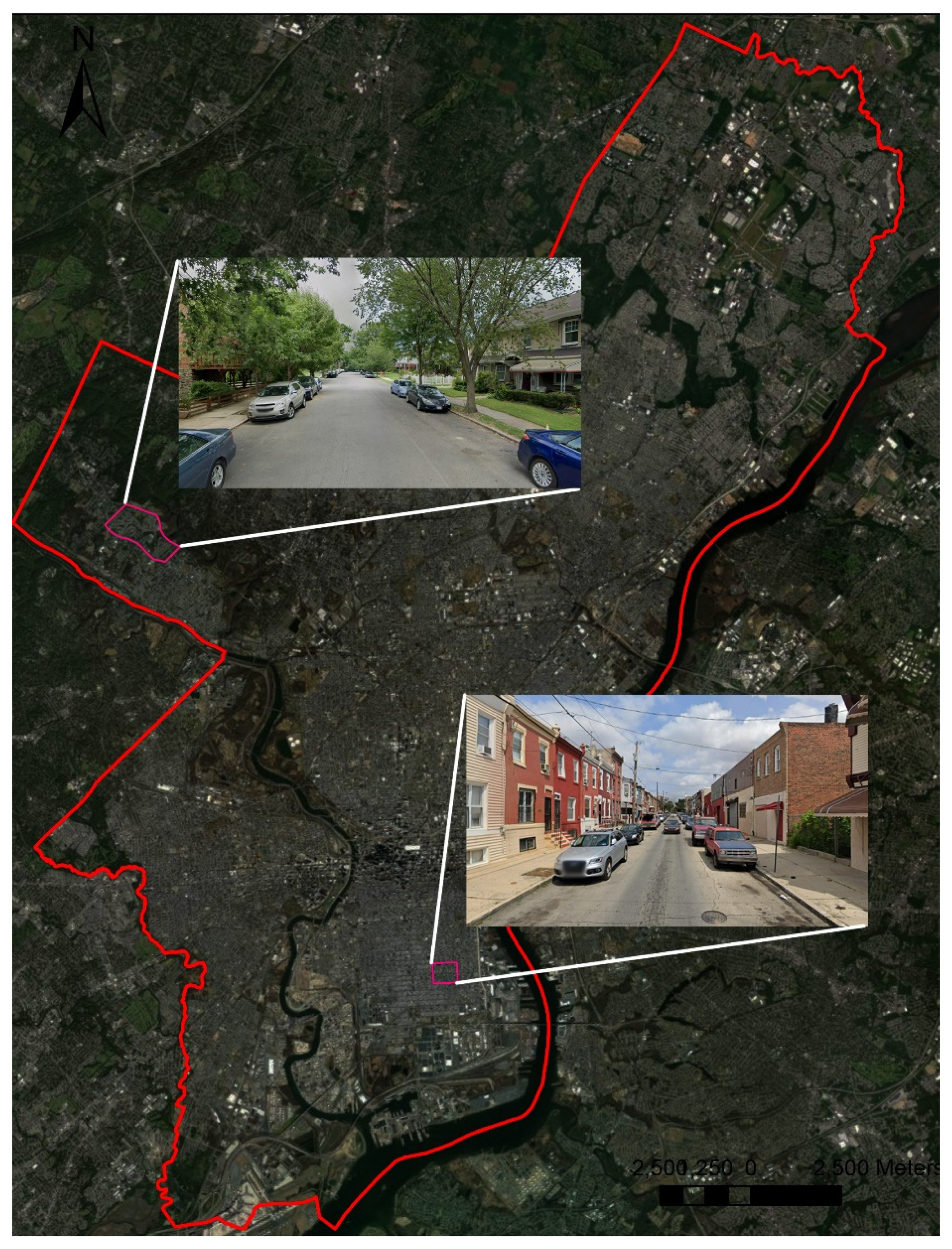
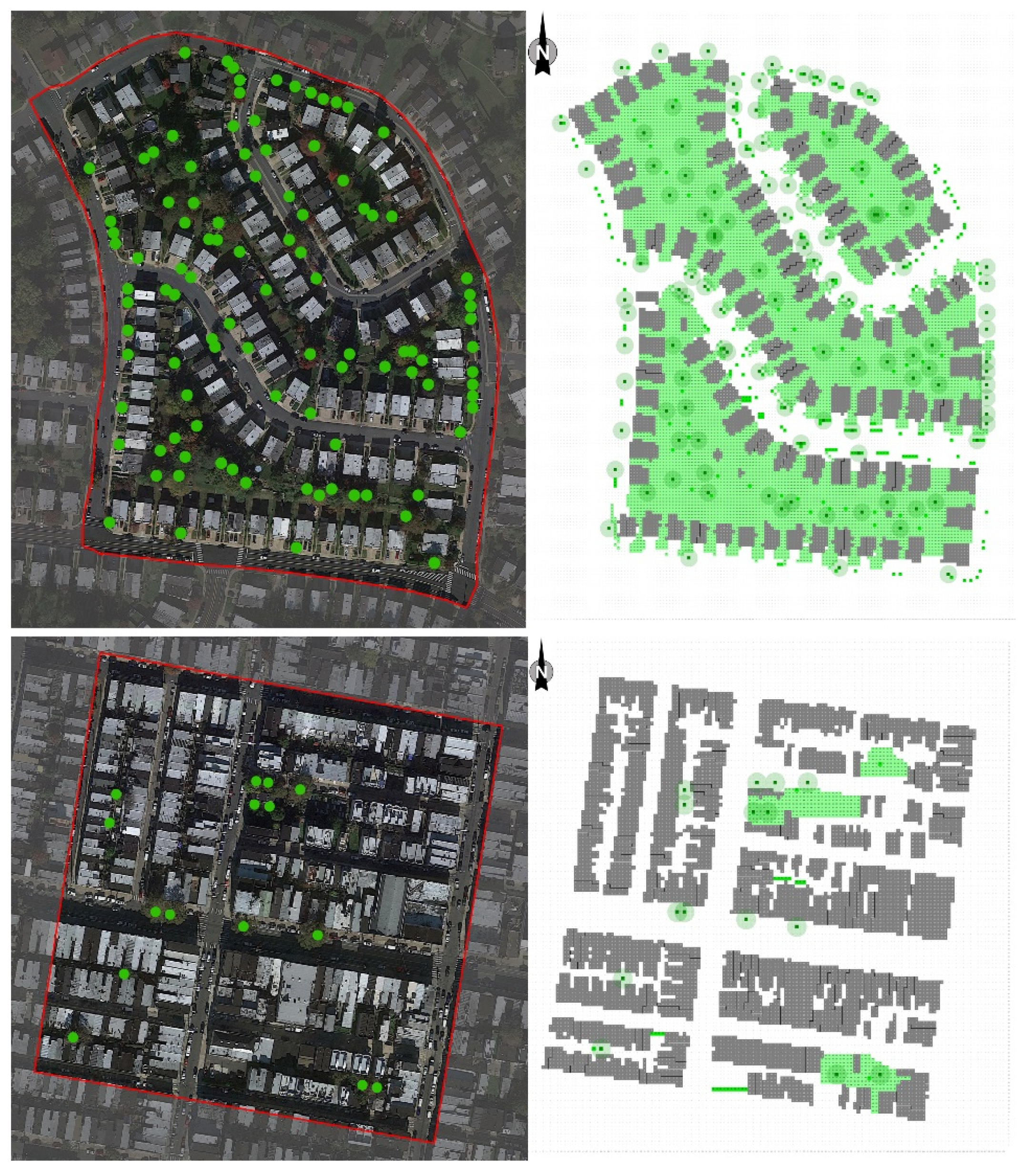

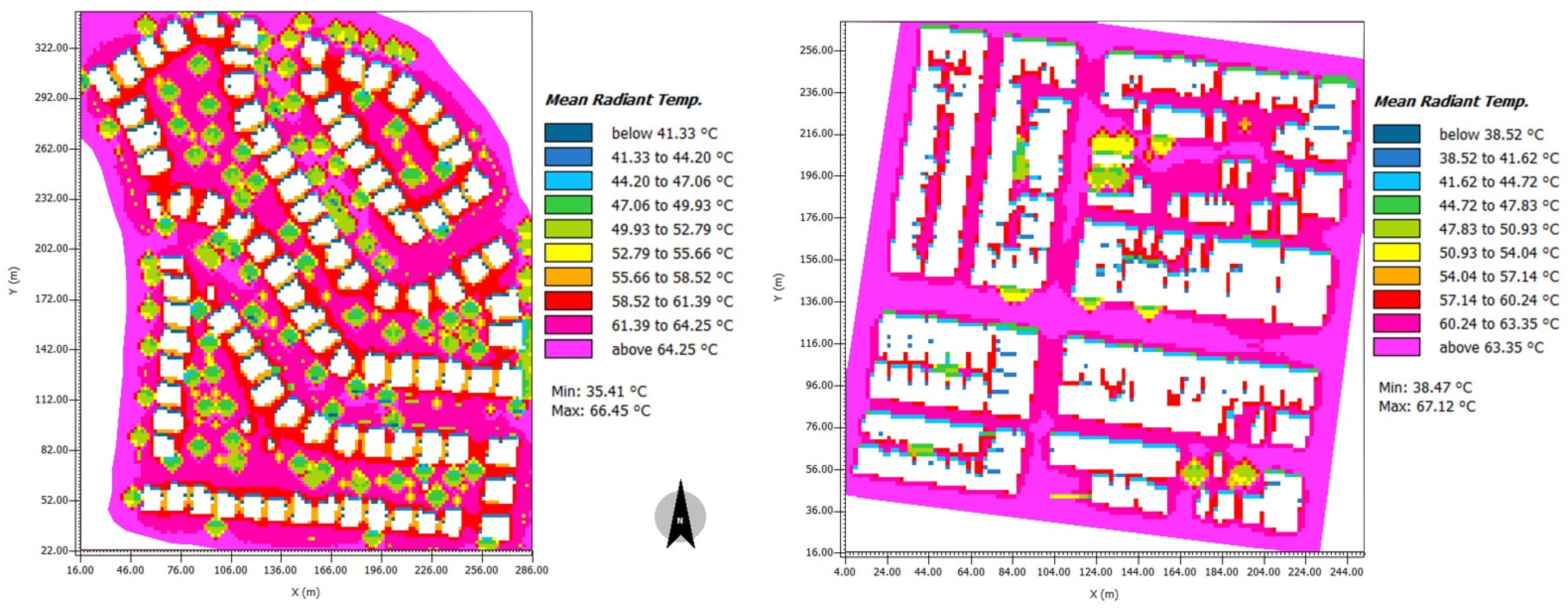

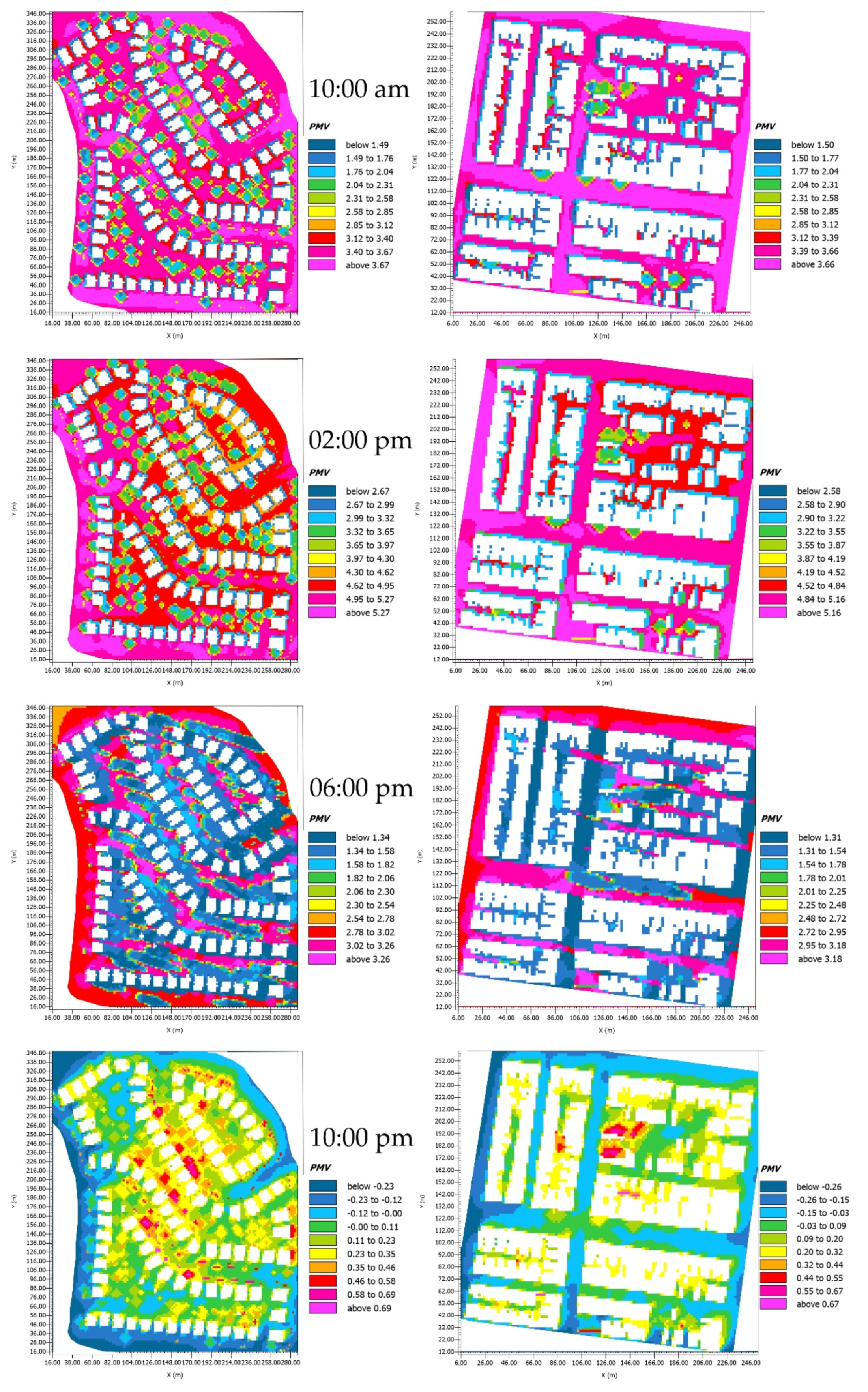
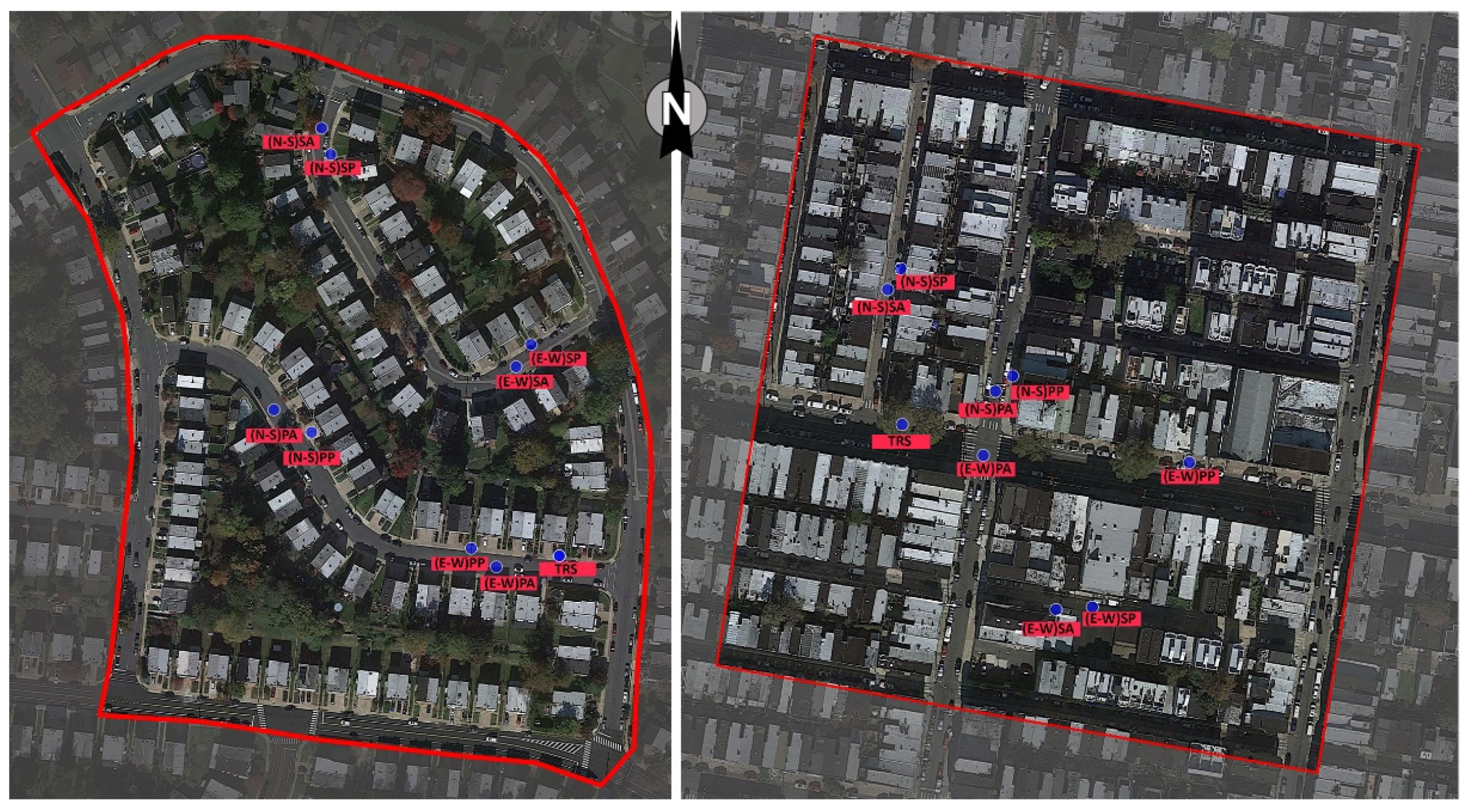

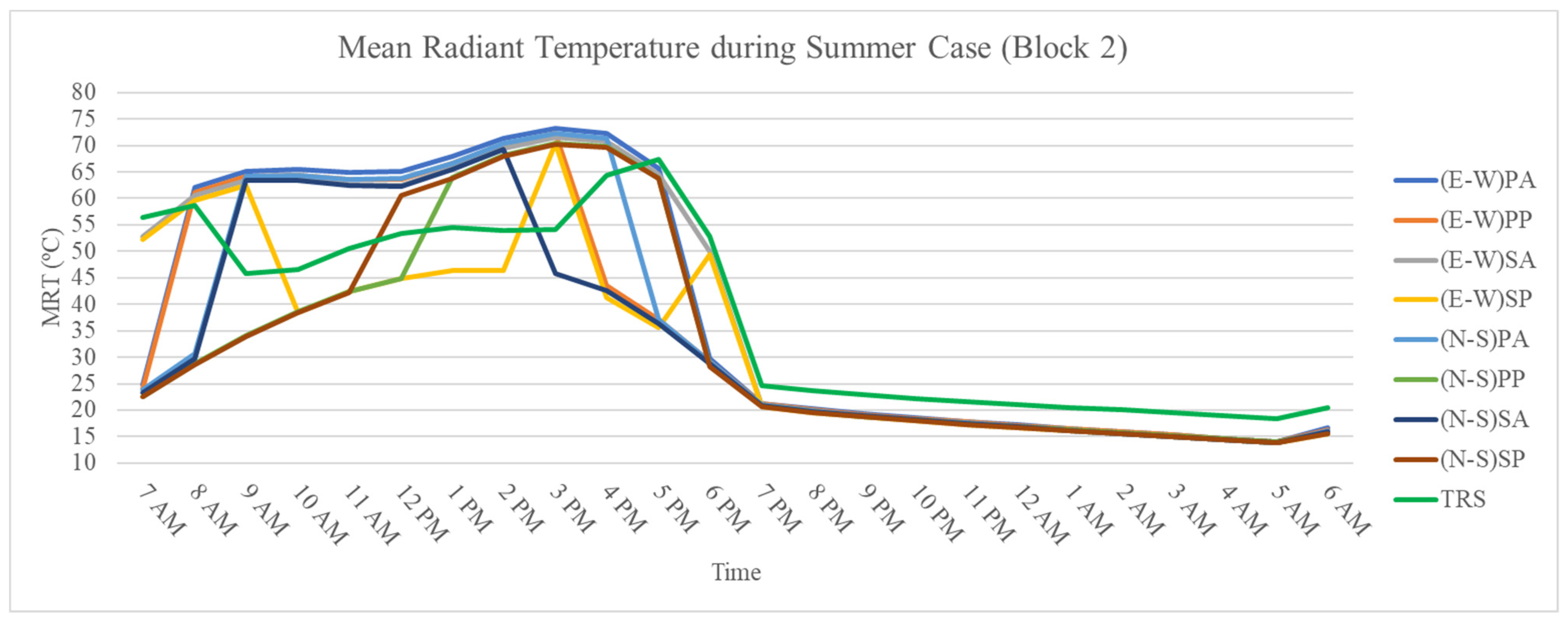
| Census Block | Model Dimensions | Site Properties | |||||||
|---|---|---|---|---|---|---|---|---|---|
| Site Area | Number of Buildings | Average Building Height | Site Coverage Ratio | Grass Coverage Ratio | Pavement Coverage Ratio | Road Coverage Ratio | H/W Ratio | ||
| Block 1 | 152 × 184 × 30 dx = 2 m dy = 2 m dz = 2 m | 81,182 (m2) | 183 | 6 m | 0.21 | 0.48 | 0.03 | 0.28 | 0.25 |
| Block 2 | 132 × 137 × 30 dx = 2 m dy = 2 m dz = 2 m | 53,026 (m2) | 302 | 7 m | 0.42 | 0.02 | 0.18 | 0.22 | Primary E-W: 0.32 Primary N-S: 0.5 Secondary N-S, E-W: 0.8 |
| Cases | Tmax (°C) | Tmin (°C) | TAVG (°C) | Average Wind Speed (m/s) | Wind Direction |
|---|---|---|---|---|---|
| Winter Case | 4.24 | −1.84 | 1.23 | 4.35 | NW |
| Coldest Day (2 February 2021) | 0 | −9.99 | −4.99 | 7.07 | NW |
| Summer Case | 30 | 21.6 | 25.98 | 3.34 | SW |
| Hottest Day (7 July 2021) | 35.52 | 24.42 | 29.99 | 3.52 | SW |
| Fall Case (24 October 2021) | 17 | 7.8 | 12.47 | 3.7 | SE |
| Spring Case (12 May 2021) | 20.1 | 8.48 | 14.13 | 4.11 | NW |
| Blocks | Sky View Factor (SVF) | Surface Albedo | H/W Ratio | |
|---|---|---|---|---|
| (E-W)PA | Block 1 | 0.84 | 0.2 | 0.25 |
| Block 2 | 0.78 | 0.2 | 0.32 | |
| (E-W)PP | Block 1 | 0.75 | 0.35 | 0.25 |
| Block 2 | 0.68 | 0.35 | 0.32 | |
| (E-W)SA | Block 1 | 0.84 | 0.2 | 0.25 |
| Block 2 | 0.62 | 0.2 | 0.8 | |
| (E-W)SP | Block 1 | 0.81 | 0.35 | 0.25 |
| Block 2 | 0.52 | 0.35 | 0.8 | |
| (N-S)PA | Block 1 | 0.61 | 0.2 | 0.25 |
| Block 2 | 0.70 | 0.2 | 0.5 | |
| (N-S)PP | Block 1 | 0.72 | 0.35 | 0.25 |
| Block 2 | 0.52 | 0.35 | 0.5 | |
| (N-S)SA | Block 1 | 0.66 | 0.2 | 0.25 |
| Block 2 | 0.61 | 0.2 | 0.8 | |
| (N-S)SP | Block 1 | 0.45 | 0.35 | 0.25 |
| Block 2 | 0.51 | 0.35 | 0.8 |
Disclaimer/Publisher’s Note: The statements, opinions and data contained in all publications are solely those of the individual author(s) and contributor(s) and not of MDPI and/or the editor(s). MDPI and/or the editor(s) disclaim responsibility for any injury to people or property resulting from any ideas, methods, instructions or products referred to in the content. |
© 2023 by the authors. Licensee MDPI, Basel, Switzerland. This article is an open access article distributed under the terms and conditions of the Creative Commons Attribution (CC BY) license (https://creativecommons.org/licenses/by/4.0/).
Share and Cite
Hashemi, F.; Poerschke, U.; Iulo, L.D.; Chi, G. Urban Microclimate, Outdoor Thermal Comfort, and Socio-Economic Mapping: A Case Study of Philadelphia, PA. Buildings 2023, 13, 1040. https://doi.org/10.3390/buildings13041040
Hashemi F, Poerschke U, Iulo LD, Chi G. Urban Microclimate, Outdoor Thermal Comfort, and Socio-Economic Mapping: A Case Study of Philadelphia, PA. Buildings. 2023; 13(4):1040. https://doi.org/10.3390/buildings13041040
Chicago/Turabian StyleHashemi, Farzad, Ute Poerschke, Lisa D. Iulo, and Guangqing Chi. 2023. "Urban Microclimate, Outdoor Thermal Comfort, and Socio-Economic Mapping: A Case Study of Philadelphia, PA" Buildings 13, no. 4: 1040. https://doi.org/10.3390/buildings13041040
APA StyleHashemi, F., Poerschke, U., Iulo, L. D., & Chi, G. (2023). Urban Microclimate, Outdoor Thermal Comfort, and Socio-Economic Mapping: A Case Study of Philadelphia, PA. Buildings, 13(4), 1040. https://doi.org/10.3390/buildings13041040








